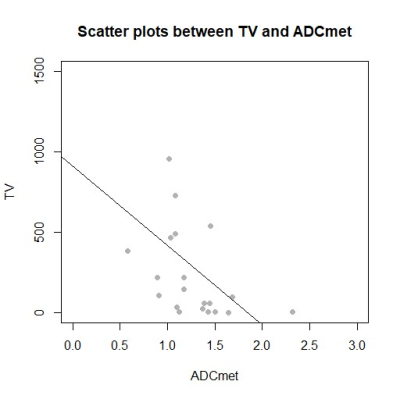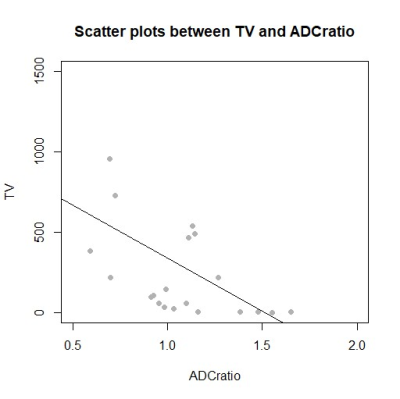3839
Relationship of apparent diffusion coefficient on diffusion-weighted imaging and tumour burden in ovarian cancer1The University of Hong Kong, Hong Kong, Hong Kong, 2Philips Healthcare, Hong Kong, Hong Kong
Synopsis
To investigate the relationship of apparent diffusion coefficient (ADC) on diffusion-weighted imaging (DWI) and tumour burden in ovarian cancer. The ADC of primary ovarian tumour (ADCpri), peritoneal carcinomatosis (ADCmet), and the ratio of ADCmet/ADCpri (ADCratio) were correlated with the total tumour volume (TV) contoured on T2WI as representation of tumour burden in ovarian cancer. Significant correlations were found between ADCmet and TV, and between ADCratio and TV. Our study suggested that the analysis of ADC might provide important information on tumour burden in OC.
Introduction
Ovarian cancer is one of the most common and leading causes of gynecological cancer death in women all over the world [1]. The occurrence of peritoneal carcinomatosis (PC) is prevalent and its burden impacts upon treatment outcome [2]. Surgery is currently the most accurate way to assess PC burden, but it is costly and invasive [1]. Diffusion-weighted imaging (DWI) has been suggested to be useful in PC detection and can provide information on the proportion of inter- and extra-cellular water protons change using apparent diffusion coefficient (ADC) [3]. However, the relationship between ADC and tumour burden is not fully investigated. Our study aimed to evaluate the relationship between ADC and tumour burden in ovarian cancer (OC).Methods
Patients with stage III/IV primary OC were prospectively recruited from February 2016 to September 2017. DWI and standard pelvic MRI was performed on a 3.0T scanner (Achieva 3.0 T TX, Philips Healthcare, Best, the Netherlands) before the initiation of treatment. DWI was acquired using single-shot spin-echo echo-planar imaging in free breathing with background body signal suppression using 3 b values (0, 400, 800 s/mm2). Parametric maps of ADC were generated in MATLAB (R2015b, The Mathworks Inc.). The tumour burden as evaluated by the sum of all tumour volumes (TV), which were manually delineated on axial T2WI. The primary lesion and the largest PC of each patients were chosen. A region of interest (ROI) was placed on ADC map to cover the whole tumour on the slice in which the tumour appeared largest. A similar ROI was placed in the selected largest PC. The mean ADC within the ROI drawn on the primary lesion was noted as ADCpri, and the mean ADC within the ROI of PC was noted as ADCmet (Figure 1). ADCratio was calculated as ADCmet/ADCpri. After testing for normality using the Shapiro-Wilks test (P<0.05), the TV and ADC were described as the median and interquartile range (IQR). The correlation between ADC and TV was analysed using Pearson correlation coefficient (r).Results
We evaluated 21 patients with stage III/IV primary OC. Their median of age was 55.48 (range:19 – 82 years old). The median of TV was 295.19 mm3 (IQR: 0.75-11.23 mm3). The median of ADCpri, ADCmet and ADCratio were 1.18 (IQR: 0.97 - 1.39) × 10-3 mm2/s, 1.17 (IQR: 1.03 - 1.45) × 10-3 mm2/s, 1.03 (IQR: 0.90 - 1.19), respectively. Both ADCmet (p = 0.044, r = -0.444) and ADCratio (p = 0.037, r = -0.458) were significantly correlated with TV. ADCpri (p = 0.116) showed no significant correlation with TV. Both ADCmet and ADCratio showed negative relationships with TV (Figures 2 & 3).Discussion
Our results showed that both ADCmet and ADCratio was significantly correlated with TV. In contrast, ADCpri alone was not associated with TV. Our findings suggested that ADC analysis of PC might be more informative than the primary lesion on tumour burden, demonstrating the heterogeneity between ADC of primary lesion and PC [4]. Tumour burden has been established as one of the most important predictor of surgical outcome and overall survival in OC. Surgery is currently the most reliable method to assess PC burden but has its own limitations [1]. DWI is a non-invasive method with emerging role in PC detection. Our results suggested that the evaluation of ADCmet or ADCratio may provide important information on tumour burden.Conclusion
The ADCmet and ADCratio was negatively correlated with tumour volume in OC and might serve as a non-invasive functional tool for tumour burden estimation.Acknowledgements
N.A.References
1. Ledermann, J.A., et al., Newly diagnosed and relapsed epithelial ovarian carcinoma: ESMO Clinical Practice Guidelines for diagnosis, treatment and follow-up. Ann Oncol, 2013. 24 Suppl 6: p. vi24-32.
2. Yang, L., et al., Neoadjuvant chemotherapy versus primary debulking surgery in advanced epithelial ovarian cancer: A meta-analysis of peri-operative outcome. PLoS One, 2017. 12(10): p. e0186725.
3. Surov, A., H.J. Meyer, and A. Wienke, Correlation between apparent diffusion coefficient (ADC) and cellularity is different in several tumors: a meta-analysis. Oncotarget, 2017. 8(35): p. 59492-59499.
4. Lindgren, A., et al., Primary and metastatic ovarian cancer: Characterization by 3.0T diffusion-weighted MRI. Eur Radiol, 2017. 27(9): p. 4002-4012.


